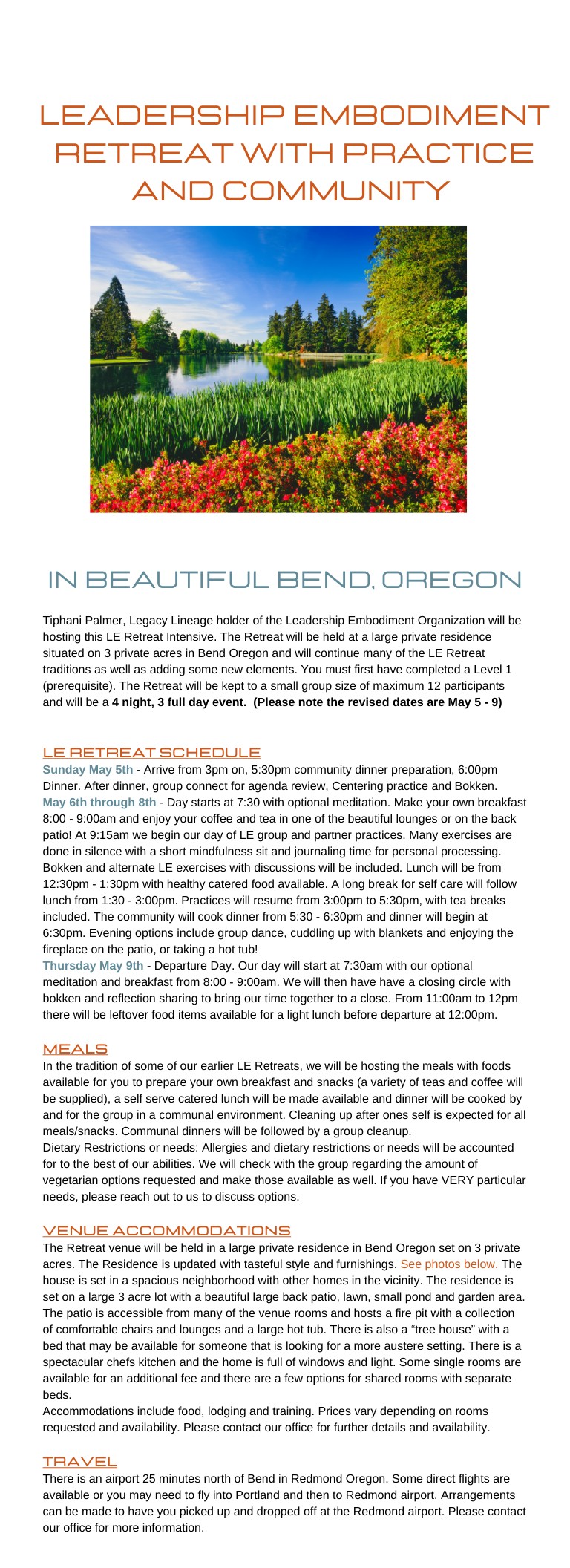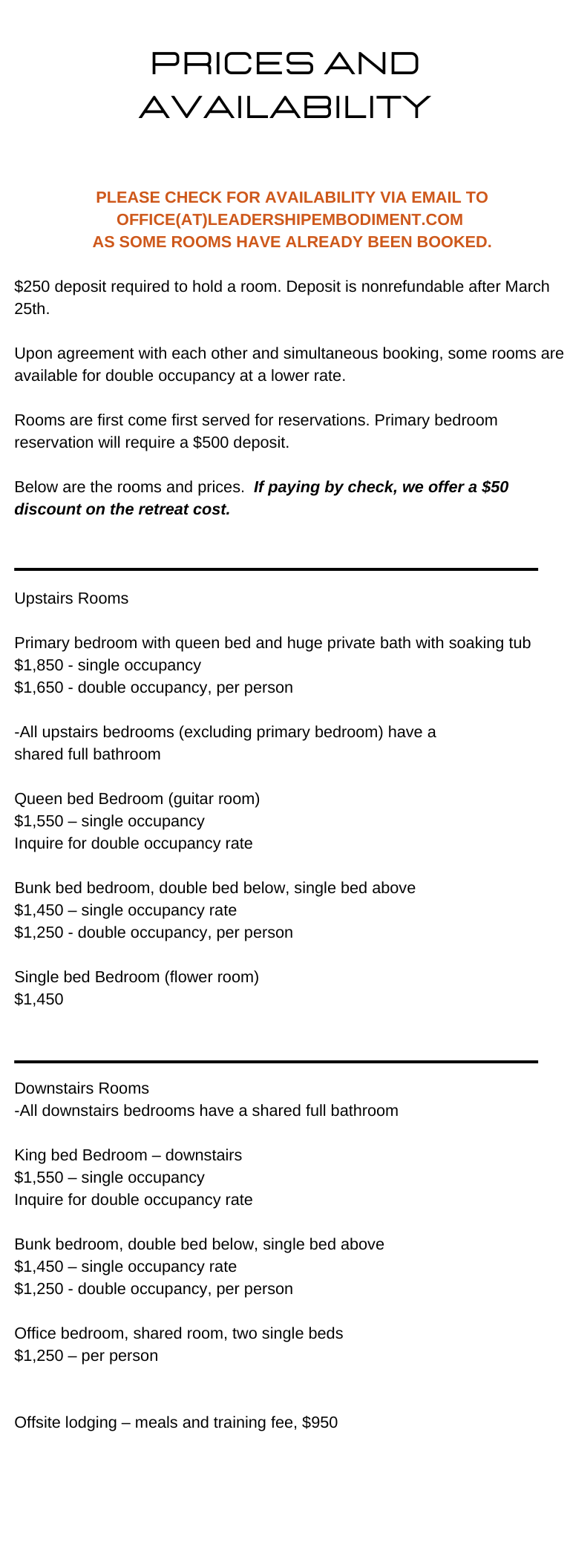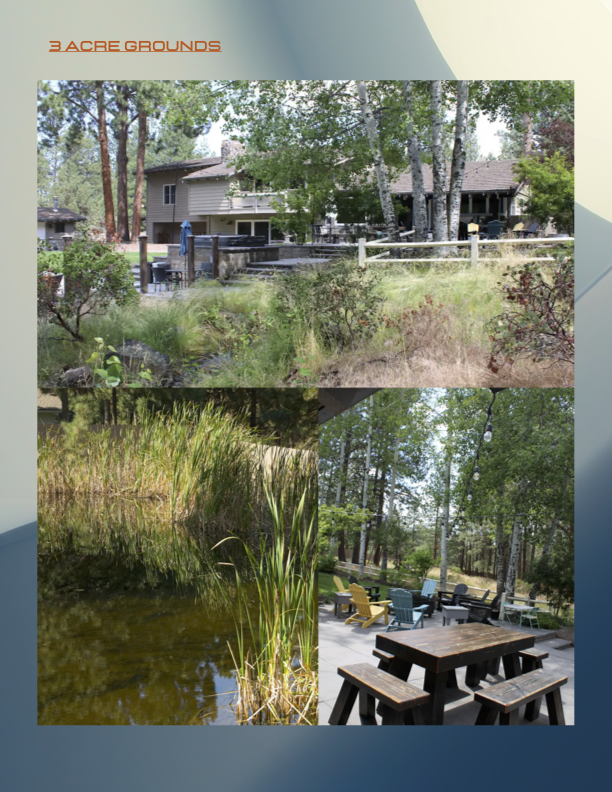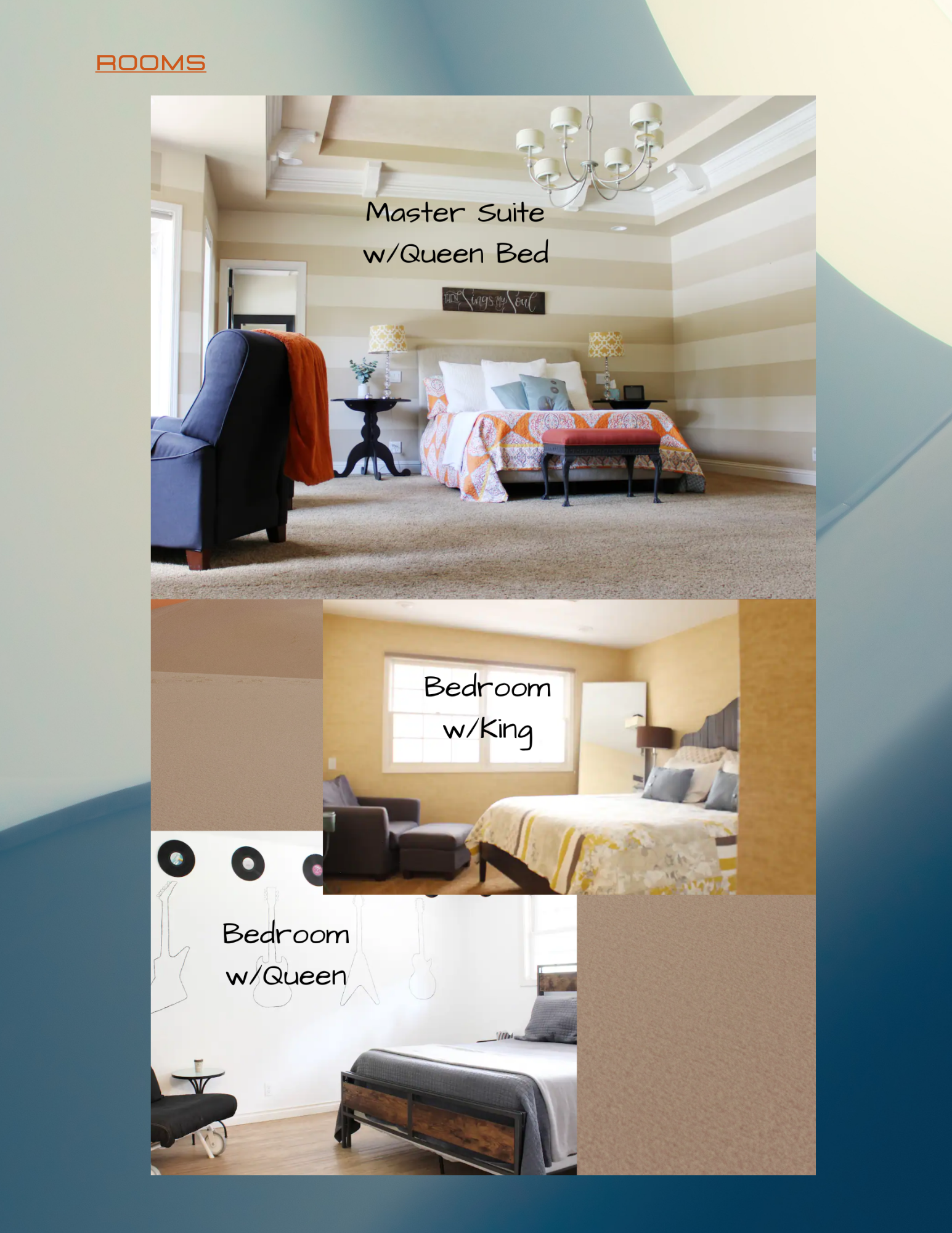This video was filmed at The DO Lectures in 2013 and continues to inspire (and entertain) each time it’s viewed. If you haven’t seen it, you’re in for a delightful 25 minutes.
Tiphani leads an Intensive Leadership Embodiment Retreat at the Samye Ling Monastery in Scotland. This retreat includes lodging and meals. For the Samye Ling retreat, we are requiring completion of both a Leadership Embodiment Level 1 and Level 2. For a description of our retreats, please see our Public Courses page. For more information on Samye Ling, please see the Visiting Page of their website.
The retreat includes meals and three nights lodging.
Costs: $1,250 per person for Retreat with 3 nights lodging and meals. (LE Associates, please contact our office for associate discounted rates.) The retreat cost covers September 10th – 13th lodging and meals (beginning with dinner on the 10th and ending with lunch on the 13th). A USD$250 deposit will hold your spot. This is refundable until July 25, 2024. The balance is due before August 1st and is not refundable unless the retreat is canceled by either Leadership Embodiment or Samye Ling. Payment can be made by wire transfer or we can send an invoice via our credit card processor (Square).
If any participants will need extra nights added on to their booking (before or after the retreat), they can contact Samye Ling at this email address: bookings@samyeling.org to make those arrangements.
You’ll need to provide Samye Ling with the following information to make additional night(s) booking:
– your date of arrival and departure (outside of the retreat dates)
– the full name of each guest on the booking
– your contact number
– what time you aim to arrive at reception (check in is from 3.30pm and supper is served at 6pm)


Our Spring Newsletter is now available. You can find it here at this link.
The Leadership Embodiment Winter Newsletter is out. Please note the revised dates for the Bend, Oregon Retreat are May 5-9, 2024. You can check it out HERE.








Our summer newsletter includes an inspirational note from Tiphani Palmer. You may CLICK HERE to view it.
by Anouk Brack, MSc.
Embodiment has already been applied successfully in many businesses and organizations in the last 4 decades. It has much to offer to improve leadership, communication, and innovation in organizations. The added value is supported by the recent increase in findings from neuroscience and psychology that is showing that the way we sit and stand changes the way we think, feel, and speak. Embodiment in organizations shows the body as a short-cut for changing our state and improving our results.
Working in today’s high pressure environments easily triggers our bodily stress systems. When many employees function in this survival-mode often, it starts to have a negative effect on team communication, employee morale and health, innovation capacity, and company bottom-line.
The solution to these problems is not to be found in more of the same knowledge-based capacity building. It is advisable to implement an embodiment component in training and coaching. Employees can practice self-regulating their state of being and restore, even increase, their confidence, connection, and clarity. Practice creates physiologically supported, embodied competency.
Practicing embodiment in organizations can be as simple as teaching employees a one minute 4-step centering process. It can help cultivate well-being in business and manifest a more conscious capitalism in the world.
Businesses not yet implementing embodiment in their Human Resource Development Policy might find themselves lagging behind in the coming years. The early adopters have been “on” it for decades already, seeing its continued use and aiding in its continued development. Some examples of the many businesses and organizations that have benefited from implementing embodiment work are: NASA, Hewlett Packard, Oracle, McKinsey, AFM (Dutch Authority for the Financial Markets), NHS (National Health Services, UK), CSA (Coaching Supervision Academy), NTR (Dutch Broadcast Agency), BBC (British Broadcast
Corporation), WUR (Wageningen University and Research centre). There are many more.
The seeds of embodiment as a useful method for human development were planted some decades ago in the sixties and seventies in the human potential movement (HPM) in California in the USA.¹ A few well-known proponents of that movement are George Leonard, Michael Murphy, and Jean Houston. Examples of teachers and writers responsible for subsequently shaping the field of embodiment are Wendy Palmer², George Leonard, Richard Strozzi-Heckler³ and Paul Linden⁴.
After a gestation period of a couple of decades of testing and improving, the time seems ripe now for it to come to fruition in the mainstream. Two trends are supporting this claim: firstly, the immense rise in popularity of mindfulness practice as a stress reduction method. Mindfulness and embodiment are intimately linked as both have their roots in meditative practices and teach people to be more aware of the present moment. In order to cultivate mindfulness, you practice proper body posture, breath and focus. Embodiment starts with mindfulness of the body-mind system and could also be seen as mindfulness in action.
Secondly, the recent findings in neuroscience and embodied cognition support the ancient wisdom techniques (like martial arts principles) that embodiment is rooted in. More evidence for this will be presented in the science of embodiment section of this article.
In the past decades the amount of organizations implementing embodiment as a way to increase employee efficiency and well-being has been gradually increasing. The growth seems to be speeding up and its potential is impressive. Some of the variety of useful applications of embodiment in organizations are:
Embodiment is even valuable in combination with organizational development according to expert Martin Saville: “My experience is that offering appropriately designed Leadership
Embodiment work with the (senior) management as part of a wider Organization
Development initiative can help people move more effectively through a process of change.”⁵ It helps the leadership to “walk the talk” so to speak, and that has a big influence on the involvement and commitment of the workforce to contribute to the goals of the operation.
Sharing these other-than-usual types of encounters with one another increases trust, openness, and understanding. This can lead to valuable team and relationship building even when the topic of the training is focused elsewhere. Embodiment work can make communication more effective and team targets easier to reach.
There is a growing evidence-base for embodied training6. Let’s now take a look at research investigating the biological basis of effective leadership.
Power posing expert Amy Cuddy (2013) beautifully summarizes the implications of these findings on neuroscience of embodiment for effective leadership in the article “Connect, then lead”:
“A growing body of research suggests that the way to influence—and to lead—is to begin with warmth. Warmth is the conduit of influence: It facilitates trust and the communication and absorption of ideas. Even a few small nonverbal signals—a nod, a smile, an open gesture—can show people that you’re pleased to be in their company and attentive to their concerns.”
The above may seem like common-sense to many of us but as the old saying goes “Just because it’s common-sense doesn’t mean it’s common practice.” Under pressure we are even more likely to forget even the most basic things. For optimal performance our physiological and psychological state is very important. If we are too stressed or reactive, our neocortex, the part of our brain capable of creative thinking, positive risk-taking and self-reflection goes “off-line”. We suffer from what is called an amygdala hijack in which a lower part of our brain, also called reptilian brain, takes over for our safety.15 In this state we are egocentric and not able to give others a sense of connection. The well-known survival patterns fight, flight, and freeze kick in: stage fright and forgetting your point when the CEO suddenly turns his attention on you is an example of freezing. Your angry defensiveness when challenged in a meeting is a fight response. This is an unconscious and involuntary process. Our higher functions are often still aware, giving us an excruciatingly frustrating experience where we are aware of what we’re doing, but we can’t stop it.
Here we find one of the greatest benefits of applying embodiment in organizations. We can learn to recognize, prevent and recover from an amygdala hijack. Because the higher brain functions are often powerless our best chance for learning to recover is using embodiment practices where we shift our state in the body and allow this to influence brain function. During the hijack we can use deep breathing, focused muscle relaxation, and a rehearsed statement to self about the bigger picture. In Leadership Embodiment, “centering” is the basic practice for achieving exactly this.¹⁶ When we are centered, we can offer the best of ourselves to the situation and make a bigger contribution.
To reduce the chances of getting off-center, self-care in all its forms will help us — exercise, diet, relaxation, meditation. Mindfulness practice can help to raise the threshold of the amygdala hijack, thereby increasing the chances of functioning optimally more of the time.¹⁷
Amy Cuddy who I quoted at the beginning of this section on the science supporting the value of embodiment has a famous piece of research which she speaks about in a TED talk. She found that standing or sitting in a powerful pose for two minutes influences hormone levels in the bloodstream subsequently influencing the way we feel and our performance⁷ for instance in a job interview. “High power posers performed better and were more likely to be chosen for hire”⁸ due to their presentation quality (e.g., captivating, confident).
Testosterone plays a role in both men and women and is known to reduce fear in humans.⁹ “High-power posers experienced elevations in testosterone, decreases in cortisol, and increased feelings of power and tolerance for risk; low-power posers exhibited the opposite pattern.”¹⁰
This work is often referred to as relating to body language, but the participants were not taught to adjust their body language in the interview situation, they stood or sat differently for 2 minutes beforehand. They shifted their state and that state improved their performance.
Another important hormone is oxytocin. Oxytocin and possibly endorphins¹¹ increase trust¹² and a sense of connection. Oxytocin also has an anti-stress and relaxation effect¹³. A way to increase oxytocin levels is to do “[…] self-massage, an activity that has been shown to lead to secretion of the hormone oxytocin, and the calm-and-connection response, which results in attenuation of arousal and stress levels.”¹⁴
While this could be difficult to apply in the midst of a board meeting it is a simple and free method of self-care that can be applied in a quiet moment and could improve your performance by making you a better connector – and therefore a better leader – to draw inspiration from Cuddy’s article ‘Connect, then lead’.
Since I am trained as a certified Leadership Embodiment trainer / coach and know many people in that community, I have taken the following specific examples from there. Leadership Embodiment was developed for use in businesses and organizations by Wendy Palmer. As with many of the other schools of embodiment, it developed out of the combination of Aikido, a Japanese martial art, and mindfulness, which itself comes out of Buddhism. During the last 30-40 years it has been refined for accessible and religion free use for professionals in organizations without any specific martial art or meditation background. It works with posture, breath and focus and teaches people how to influence their state of being with ease. The core of the practice is to recognize being in a stressful state and swiftly self-regulating into a flow-state.
Louise Robb¹⁸ is a certified professional facilitator, for the case described she worked with an international NGO based in central Europe. It was part of a two-day team retreat with 30 people. Participants were doctors, specialists, managers, administration staff, all with at least a Masters degree. Purpose of the training was to deal with the stress that fast reorganization had put on the faculty and to come to acceptance of the new situation. The embodiment part of the training consisted of half a day of Leadership Embodiment exercises like centering under pressure, exploring the body’s pattern whilst under pressure and how to benefit from these practices in everyday office situations.
Responses from participants were: “Wow. I feel strong and peaceful”, “This is rubbish”, and “In handling difficult situations it is not about developing skills to handle a situation, however more importantly is in managing ourselves and own emotions when in the face of conflict. This most insightful learning is the Aikido technique (Leadership Embodiment).”
On the subject of the benefit of embodiment practice Louise remarks:
“I cannot do good work without it now.”
“It’s easy now to introduce, it was scary at first. It’s backed by so much science and knowledge in the mainstream and if you can just get people to try, what they feel as a result speaks for itself. In one organization I have worked with over 1000 participants over the world and have feedback from them all about the two days we have the workshop and 80% remember the breathing and Aikido (their words for LE) saying they have shown their families and are using it every day at work to cope. It’s only the very start for them, but it seems to make a big difference.”
Leanne Lowish¹⁹ is a coaching supervisor trained in Leadership Embodiment. In this case she trained three groups of about ten self-selected coaches for the CSA (Coaching Supervision Academy) in two sessions of 2-4 hours. It was part of a piece on relational presence using embodiment techniques to explore what takes us out of being present and how to come back to presence. She used exercises on receiving criticism without taking it personally, a practice of gracefully interrupting, and leading and following.
A response from a participant was: “Find it enormously powerful”.
The added benefit of embodiment practice according to Leanne:
“It’s an excellent way of showing people how easily they are pulled out of presence and how simply they can come back. Also good for them to see their patterns and be able to identify them in their work with clients.”
She notices it is easier nowadays to implement embodiment. The argument she uses mostly is around stress and how it pulls us out of thinking clearly and handling situations effectively.
John Tuite²⁰ is an expert in teacher presence. In this case he worked in a state secondary school (11-18 years old) with four groups of five to eight newly qualified teachers of all subjects in their first year of teaching. The program consisted of two to three sessions of two hours long. This was part of a program which included a lesson observation with one to one feedback focused on the quality of presence, rather than specifically pedagogic strategies, followed up later in the year with a one-to one coaching session. Embodiment practices were used as a doorway into exploring presence, inspiration, and connection.
A specific exercise interesting for teachers is saying “no” in different ways, creating the distinction between a no that is definite, and a no that is both definite and connecting.
The added benefit of embodiment practice according to John:
“No other way to address these issues practically, rather than academically. Builds on their experience of being in the stressful conditions of a classroom. Acknowledges the different ways they respond to it, and offers them a way to work with it. Creates some distinctions that are not addressed anywhere else, but which are desperately needed.”
With regards to making their case for embodiment in education John says:
“I don’t use the word embodiment in selling this. I use ‘presence’. I can discuss presence, but generally in terms of improving classroom management of behaviour. I talk about dealing with pressure, and the need for good teachers to be both strong and connected.”
Embodiment is a maturing field that has much to offer to improve leadership, communication, and innovation in organizations. For decades it has been applied successfully in many businesses and organizations. The added value of the application of embodiment is supported by the recent increase in findings from neuroscience and psychology. The way we sit and stand changes the way we think, feel, and speak.
In today’s busy work environments it doesn’t take much to get triggered and having our amygdala reduce us to a more tense and self-centered version of ourselves. This has a negative effect on communication, employee morale, innovation, and company bottom-line. The solution to these problems is not to be found in more of the same knowledge-based training. It is advisable to implement an embodiment component in training and coaching, so employees can practice self-regulating their state of being. They can practice recognizing, accepting, and adapting their physiological state and restore, even increase, their confidence, connection, and clarity.
It is important to understand that embodiment is a practice. We get better at applying the techniques in challenging situations, but we will fail. We cannot do it yet. This is to be expected, because the power is in the recovery. “Practice creates physiologically supported, embodied competency.”²¹
Lastly, I will indulge in a slightly utopian vision of cultivating enlightened business through incorporating embodiment practices. Naming embodiment as one of the practices that will help restore humanity in business, allowing capitalism to rise above itself and manifest its next stage of evolution: a conscious capitalism²² with more humane work environments and a more enlightened society.
Anouk Brack holds an MSc in biology, specialisation neuro-physiology. She is an expert in embodying integral leadership for sustainability. She is an executive coach and international Leadership Embodiment trainer at AnoukA.nl She welcomes connection at www.linkedin.com/in/anoukbrack.
For Full Document with Bibliography and End Notes, please CLICK HERE.
Our Spring 2023 Leadership Embodiment Newsletter is out. Be sure to read Tiphani’s uplifting message by clicking here.
We offer you the following audio tracks from Wendy Palmer’s CD “Recover Your Center”.
1. Short Centering Practice
2. Introduction to Conscious Embodiment
3. Practice for Important Conversations
4. Preparation and Warmup for Exercise
5. Practice for Calming and Renewing
6. Practice for Patients and Their Communities
7. Centering Practice to Balance & Focus Your Energy
Our Summer 2022 Newsletter has just been sent. It includes a letter from Wendy and Tiphani as well as information on upcoming courses and retreats. You can view the newsletter by CLICKING HERE.